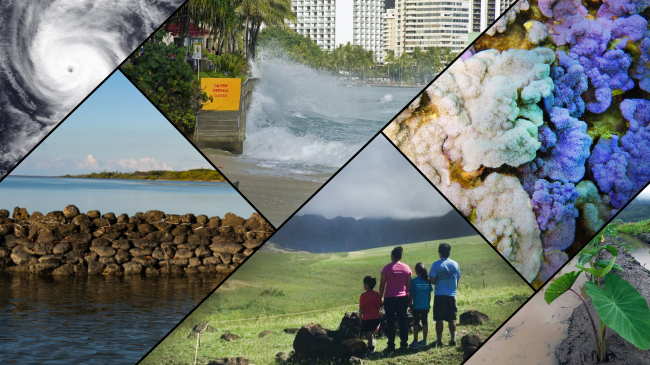NOAA offers expertise on forecasting and research for extreme heat events

Be sure to check the forecast for any excessive heat advisories in your area before venturing out. (Image credit: U.S. Department of Agriculture)
Heat is the leading cause of weather-related deaths in the United States. NOAA provides real-time forecasting and decision support for emergency managers and local communities before and during extreme heat events, as well as ongoing research into why extreme heat events occur and how communities can build equitable resilience to extreme heat through planning.
Heat.gov: Your one-stop resource for extreme heat
In July 2022, NOAA as part of the interagency National Integrated Heat Health Information System, launched Heat.gov, a new website to provide the public, decision-makers and the news media with clear, timely and science-based information to understand and reduce the health risks of extreme heat. On its homepage, Heat.gov gives real time updates on what percentage of the country is under extreme heat advisories, watches and warnings. Among a wealth of resources, Heat.gov includes heat forecasts from NOAA’s National Weather Service, the monthly Climate and Health Outlook developed by the Department of Health and Human Services, the CDC’s Heat and Health Tracker, information on the NOAA-supported Urban Heat Island Mapping Campaign.
Heat monitoring and forecasting
NOAA issues outlooks for excessive heat 8-14 days, as well as 3-7 days in advance and provides hourly forecasts, advisories, watches and warnings when dangerous heat becomes likely or imminent.
Check Weather.gov to see if your area is at risk of an excessive heat event that would trigger one of the following National Weather Service heat alerts:
- An excessive heat warning is issued within 12 to 24 hours before the onset of extremely dangerous heat conditions.
- An excessive heat watch is issued when conditions are favorable for excessive heat in the next 24 to 72 hours.
- A heat advisory is issued within 12 hours of the onset of dangerous heat conditions.
NOAA also keeps track of the proportion of the U.S. population currently under heat advisories, watches and warnings.
NOAA provides real-time heat index outlooks for excessive heat, and NOAA’s local weather forecast offices work closely with emergency managers in local communities when extreme heat is in the forecast.
NOAA’s satellites can detect the land surface temperatures during extreme heat. Data collected from NOAA’s fleet of Earth-observing satellites are the backbone of the forecast models that predict extreme heat waves across the U.S.
Stay safe during an extreme heat event with these helpful tips, and use this tool to calculate the heat index when extreme heat is in the forecast.
The climate-heat connection
Climate change can create or intensify extreme heat, but other factors play a role as well. The elements that combine to create all weather events remain the same, but a changing climate can affect one or more of those elements, so that it occurs more often or less often — or more or less intensely — over time.
According to the Intergovernmental Panel on Climate Change offsite link’s 2021 report on the physical science basis of climate change (supported by NOAA science) extremely hot days have become more frequent and more intense since the 1950s in most regions offsite link across the world. The report also finds that this trend is expected to continue with climate change driving more hot days, more compound events — which are multiple extreme events occurring simultaneously or successively and/or underlying conditions that amplify extreme event(s) — such as concurrent heat waves and droughts, and more extreme heat conditions in cities.
NOAA hosts one of the most significant archives for environmental data on Earth, including extreme heat events. These data provide the information needed to put extreme heat and intense heat waves into a historical context for exploring long-term trends.
NOAA’s Climate Resilience Toolkit provides communities with resources to build resilience to climate-related impacts, including extreme heat.
Heat coordination and research
The NOAA and Centers for Disease Control and Prevention-led National Integrated Heat Health Information System integrates heat and health information, tools and research, to provide decision-makers with information about extreme heat.
NIHHIS works to address all heat and health issues, including:
- Occupational, athletic and military exposure to heat.
- Exposure in cities that is made worse by the urban heat island effect.
- Regional impacts.
NOAA supports many efforts related to extreme heat, including an Extreme Heat Risk Initiative that provides funding to improve climate information and services to bolster heat resilience and address urban heat islands, which disproportionately impact communities of color. NOAA’s Regional Integrated Science and Assessment (RISA) teams focus on the regional impacts of compound events such as heat and drought. Earth System Science and Modeling programs also investigate heat extremes.
Heat impacts on marine systems
Extreme heat can also be destructive and deadly for marine systems. An unprecedented marine heat wave dominated the northeastern Pacific from 2013 to 2020 and upended ecosystems across a huge swath of the Pacific Ocean, causing fishery collapses and fishery disaster declarations up and down the coast. Scientists believe climate change may make marine heat waves more common in the future and developed global forecasts offsite link that can provide up to a year’s advance notice of marine heatwaves.



